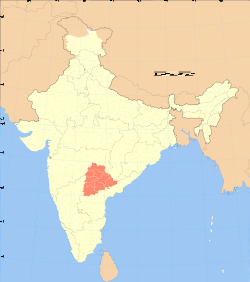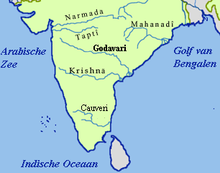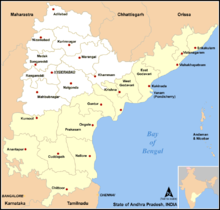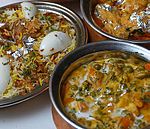- Telangana
-
Telangana
తెలంగాణ
— region — Map of India with the Telangana region highlighted in red Coordinates Country India State Andhra Pradesh Largest city Hyderabad Population
• Density
35,286,757 (2011[update])
• 307 /km2 (795 /sq mi)[1]
Official languages Telugu Time zone IST (UTC+05:30) Area 114,840 square kilometres (44,340 sq mi)[2] Telangana (Telugu: తెలంగాణ, Urdu: تیلنگانا) is a region in the present state of Andhra Pradesh, India and formerly was part of Hyderabad state which was ruled by Nizam. It is bordered with the states of Maharashtra on the north and north-west, Karnataka on the west, Chattisgarh on the north-east and Orissa to the east. Andhra Pradesh State has three main cultural regions of which Telengana is one part and others include Coastal Andhra region on the east and Rayalaseema region on the south. The Telangana region has an area of 114,840 square kilometres (44,340 sq mi), and a population of 35,286,757 (2011 census) which is 41.6% of Andhra Pradesh state population.[3][4][5]
The Telangana region comprise of 10 districts: Adilabad, Hyderabad, Khammam, Karimnagar, Mahbubnagar, Medak, Nalgonda, Nizamabad, Rangareddy, and Warangal. The Musi River, Krishna and Godavari rivers flow through the region from west to east.
Contents
History
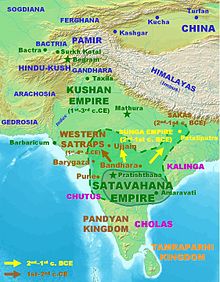 The Satavahana dynasty had its roots in Kotilingala on the banks of the Godavari River, in present day Karimnagar district
The Satavahana dynasty had its roots in Kotilingala on the banks of the Godavari River, in present day Karimnagar district
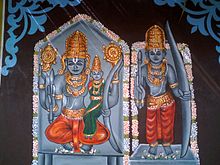 Painting of Lord Rama on a temple at Bhadrachalam in Khammam District
Painting of Lord Rama on a temple at Bhadrachalam in Khammam District
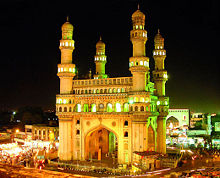 Hyderabad is the largest city of the Telangana region and of Andhra Pradesh state
Hyderabad is the largest city of the Telangana region and of Andhra Pradesh state
After the decline of the influential Mauryan Empire, the Satavahana dynasty (230 BCE to 220 CE) came to be the dominant power in the region. It originated from the lands between the Godavari and Krishna Rivers. Kotilingala in Karimnagar was their first capital, before moving to Dharanikota. Excavations at Kotilingala revealed coinage of Simukha, the first Satavahana emperor. The Satavahana Empire was important in repelling foreign empires from India, such as the Sakas and Indo-Greeks, thereby preserving Indian culture.
The region experienced its golden age during the reign of the Kakatiya dynasty, a Telugu dynasty that ruled most parts of what is now Andhra Pradesh from 1083 to 1323 AD. Ganapatideva was known as the greatest of the Kakatiyas, and the first after the Satavahanas to bring the entire Telugu area under one rule. He put an end to the rule of the Cholas, who accepted his suzerainty in the year 1210. He established order in his vast dominion that stretched from the Godavari delta in the east to Raichur (in modern day Karnataka) in the west and from Karimnagar and Bastar (in modern day Chattisgarh) in the north to Srisailam and Tripurantakam, near Ongole, in the south. It was during his reign that the Golkonda fort was constructed. Rudrama Devi and Prataparudra were prominent rulers from the Kakatiya dynasty.
The region came under the Muslim rule of the Delhi Sultanate in the 14th century, followed by Bahmanis, Qutb Shahis, and the Mughals. It was around this time that the Telugu-speaking areas under Muslim control were named Telang-Khana (Telang being a Muslim corruption of the word Telugu and Khana meaning dwelling) and later Telangana. As the Mughal Empire began to disintegrate in the early 18th century, the Muslim Asafjahi dynasty established a separate state known as Hyderabad. Later, Hyderabad entered into a treaty of subsidiary alliance with the British Empire, and was the largest and most populous princely state in India. Telangana never came under direct British rule, unlike the Circars and Rayalaseema regions of Andhra Pradesh, which were part of British India's Madras Presidency.
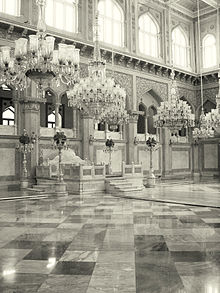 The Telangana region was the heart of numerous dynasties. Chowmahalla Palace was home to the Nizams of Hyderabad State.
The Telangana region was the heart of numerous dynasties. Chowmahalla Palace was home to the Nizams of Hyderabad State.
Telangana Rebellion
Main article: Telangana RebellionThe Telangana Rebellion was a peasant revolt which was later supported by the Communists. It took place in the former princely state of Hyderabad between 1946 and 1951. This was led by the Communist Party of India.[6]
The revolt began in the Nalgonda district and quickly spread to the Warangal and Bidar districts. Peasant farmers and labourers revolted against the local feudal landlords (jagirdars and deshmukhs) and later against the Osman Ali Khan, Asif Jah VII. The initial aims were to do away with illegal and excessive exploitation meted out by these feudal lords in the name of bonded labour (Vetti Chakiri). The most strident demand was for all debts of the peasants to be written off.[7][8]
Among the well-known individuals at the forefront of the movement were leaders like Ravi Narayan Reddy,Arutla Ramchandra Reddy,Dr.Arutla Kamala devi, Nalla Narasimhulu, Sateesh Arjula, Anabheri Prabhakar Rao, Puchalapalli Sundaraiah, Chandra Rajeswara Rao, Suddala Hanumanthu, the Urdu poet Makhdoom Mohiuddin, Hassan Nasir, Bhimreddy Narasimha Reddy, Mallu Venkata Narasimha Reddy, Mallu Swarajyam.[8][9] [10]
The violent phase of the movement ended after the central government sent in the army. Starting in 1951, the CPI shifted to a more moderate strategy of seeking to bring communism to India within the constraints of Indian democracy.[11]
Post-independence
When India became independent from the British Empire in 1947, the Nizam of Hyderabad did not want to merge with Indian Union and wanted to remain independent under the special provisions given to princely states. He even asked for a corridor, a passage from India. Rebellion had started throughout the state against the Nizam's rule and his army, known as the Razakars. The Government of India annexed Hyderabad State on 17 September 1948, in an operation by the Indian Army called Operation Polo. When India became independent, Telugu-speaking people were distributed in about 22 districts, 9 of them in the former Nizam's dominions of the princely state of Hyderabad, 12 in the Madras Presidency (Northern Circars), and one in French-controlled Yanam.
The Central Government appointed a civil servant, M. K. Vellodi, as First Chief Minister of Hyderabad State on 26 January 1950. He administered the state with the help of bureaucrats from Madras State and Bombay State. In 1952, Dr. Burgula Ramakrishna Rao was elected Chief minister of Hyderabad State in the first democratic election. During this time there were violent agitations by some Telanganites to send back bureaucrats from Madras state, and to strictly implement rule by natives of Hyderabad.[12]
Meanwhile, Telugu-speaking areas in the Northern Circars and Rayalaseema regions were carved out of the erstwhile Madras state on the fast unto death by Potti Sri Ramulu to create Andhra State in 1953, with Kurnool as its capital.[13][14][15]
Merger of Telangana and Andhra
In December 1953, the States Reorganization Commission was appointed to study the creation of states on linguistic basis.[16] The States Reorganisation Commission (SRC) was not in favour of an immediate merger of Telangana region with Andhra state, despite their common language.
Paragraph 382 of the States Reorganisation Commission Report (SRC) said "opinion in Andhra is overwhelmingly in favour of the larger unit; public opinion in Telangana has still to crystallize itself. Important leaders of public opinion in Andhra themselves seem to appreciate that the unification of Telangana with Andhra, though desirable, should be based on a voluntary and willing association of the people and that it is primarily for the people of Telangana to take a decision about their future".
The people of Telangana had several concerns. The region had a less-developed economy than Andhra, but with a larger revenue base (mostly because it taxed rather than prohibited alcoholic beverages), which people of Telangana feared might be diverted for use in Andhra. They feared that planned irrigation projects on the Krishna and Godavari rivers would not benefit Telangana proportionately, even though people of Telangana controlled the headwaters of the rivers. It was feared that the people of Andhra, who had access to higher standards of education under the British rule, would have an unfair advantage in seeking government and educational jobs.[citation needed]
The commission proposed that the Telangana region be constituted as a separate state with a provision for unification with Andhra state, after the 1961 general elections, if a resolution could be passed in the Telangana state assembly with a two-thirds majority.
The Chief Minister of Hyderabad State, Burgula Ramakrishna Rao, expressed his view that a majority of Telangana people were against the merger.[17] He supported the Congress party's central leadership decision to merge Telangana and Andhra despite opposition in Telangana.[18] Andhra state assembly passed a resolution on 25 November 1955 to provide safeguards to Telangana. The resolution said, "Assembly would further like to assure the people in Telangana that the development of that area would be deemed to be special charge, and that certain priorities and special protection will be given for the improvement of that area, such as reservation in services and educational institutions on the basis of population and irrigational development."[19] Telangana leaders did not believe the safeguards would work.[20][21] With lobbying from Andhra Congress leaders and with pressure from the Central leadership of Congress party, an agreement was reached between Telangana leaders and Andhra leaders on 20 February 1956 to merge Telangana and Andhra with promises to safeguard Telangana's interests.[22][23]
Prime minister Jawaharlal Nehru initially was skeptical of merging Telangana with Andhra State, fearing a "tint of expansionist imperialism" in it.[24][25] He compared the merger to a matrimonial alliance having "provisions for divorce" if the partners in the alliance cannot get on well.[26][27]
Following the Gentlemen's agreement, the central government established a unified Andhra Pradesh on November 1, 1956.[13][28][29] The agreement provided reassurances to Telangana in terms of power-sharing as well as administrative domicile rules and distribution of expenses of various regions.
Anti-Nehru politics emerged with the repression of the Telengana movement; many within the Congress Party extended their hands to leftist causes. Feroze Gandhi was among them.[30]
Bhadrachalam Revenue Division a part of East Godavari District up to 1959, was merged into Khammam district for geographical contiguity and administrative ease. Same was the case with Ashwaraopet also a part of West Godavari District up to 1959.
Separate Telangana state movement
Main article: Telangana movementGrievances of Telangana proponents
Telangana is the largest of the three regions of Andhra Pradesh state, covering 41.47% of its total area. It is inhabited by 40.54% of the state's population and contributes about 76% of the state's revenues, excluding the contribution of the central government. When the central government's contribution to revenue is included, Andhra Pradesh's revenue sources come from Telangana: 61.47% (including 37.17% from Hyderabad); from the central government: 19.86%; from Andhra: 14.71%; and from Rayalaseema: 3.90%.[31] Proponents of a separate Telangana state cite perceived injustices in the distribution of water, budget allocations, and jobs. Within the state of Andhra Pradesh, 68.5% of the catchment area of the Krishna River and 69% of the catchment area of the Godavari River are in the Telangana region. Telangana supporters state that the benefits of irrigation through the canal system under major irrigation projects is accruing substantially, 74.25%, to the Coastal Andhra region, while the share to Telangana is 18.20%. The remaining 7.55% goes to the Rayalaseema region. The state's expenditure on Telangana's major irrigation projects is 18.20% of the total expenditure.[citation needed]
The share of education funding for Telangana ranges from 9.86% in government-aided primary schools to 37.85% in government degree colleges. The above numbers include the expenditure in Hyderabad. Budget allocations to Telangana are generally less than 1/3 of the total Andhra Pradesh budget. There are allegations that in most years, funds allocated to Telangana were never spent. According to Professor Jayashankar only 20% of the total Government employees, less than 10% of employees in the secretariat, and less than 5% of department heads in the Andhra Pradesh government are from Telangana; those from other regions make up the bulk of employment.[32][33][34] He also alleged that the state was represented by Telangana chief ministers for only 6 1/2 years out of over five decades of its existence, with no chief minister from the region being in power continuously for more than 2 1/2 years.[32] As per Srikrishna committee on Telangana, Telangana held the position of CM for 10.5 years while Seema-Andhra region held it for 42 years.[35] Proponents of a separate Telangana state feel that the agreements, plans, and assurances from the legislature and Lok Sabha over the last fifty years have not been honoured, and as a consequence Telangana has remained neglected, exploited, and backward. They allege that the experiment to remain as one state has proven to be a futile exercise and that separation is the best solution.[36][37][38]
History of the movement
In December 1968 Osmania University students organised a rally to protest against discrimination in government jobs against Telangana people. Keshav Rao Jadhav and Sudershan Singh both teachers supported the students. Discontent intensified when some of the guarantees agreed upon were supposed to lapse in January, 1969. Student agitation for the proper implementation of the guarantees began at Osmania University in Hyderabad and spread to other parts of the region.[39] This agitation came to an end in September 1972 with the merger of Telangana Praja Samithi with Congress and people realised that the Prime Minister was not inclined towards a separate state of Telangana.[40]
Due to Jai Andhra agitation in the Seema-Andra region in 1973, protesting against the protections (mulki rules) given for Telangana region, the Government of India diluted the protections in Gentlemen's agreement by initiating the Six point formula.
Various political parties were formed on a platform of pursuing for separate statehood for Telangana region, including the Telangana Praja Samithi party in 1969, which won 11 out of 13 Parliamentory seats in 1971.[41][42]
In the 1990s, the Bharatiya Janata Party (BJP) promised a separate Telangana state if they came to power.[43]
A new party called Telangana Rashtra Samithi (TRS), led by Kalvakuntla Chandrashekar Rao (KCR), was formed in 2001 with the single-point agenda of creating a separate Telangana State with Hyderabad as its capital.[44]
In the 2004 Assembly and Parliament elections, the Congress party promised a separate Telangana State and the TRS had an electoral alliance in the Telangana region.[45] Congress came to power in the state and formed a coalition government at the centre. TRS joined the coalition government in 2004 and was successful in making a separate Telangana state a part of the common minimum programme of the coalition government.[46]
In September 2006, TRS withdrew support from the Congress-led coalition government because of the failure of fulfilling the promise to create a separate Telangana state.[47][48][49]
In July 2008, Devender Goud and E. Peddi Reddy resigned from Telugu Desam Party(TDP) and formed a new party called Nava Telangana Praja Party (NTPP) with Telangana formation as its main goal.[50]
After extensive internal discussions, the TDP, the main opposition party in the state, announced its support for the creation of separate Telangana state on 9 October 2008.[51] The Telugu Desam Party promised to work towards creation of separate Telangana state.
The Praja Rajyam Party (PRP), founded by Telugu Matinee cinema actor Chiranjeevi, supported Telangana statehood.[52] The Nava Telangana Praja Party announced that it would merge with PRP after it concluded that there was not enough political space for two sub-regional Telangana parties that had Telananga statehood as their main agenda.[53][54]
On 29 November 2009, TRS president K. Chandrashekar Rao (KCR) started a fast-unto-death, demanding that the Congress party introduce a Telangana bill in Parliament. He was arrested by the government of Andhra Pradesh.[55][56][57][58][59] Student organizations, employee unions, and various organizations joined the movement.[60][61] [62] General strikes shut down Telangana on 6 and 7 December.[63] Student organizations planned a massive rally at the state Assembly on 10 December. The government warned that the rally did not have permission and deployed police troops throughout Telangana.[64] All opposition parties in the state favoured creation of Telangana state at an all-party meet held on 7 December.[65]
On 9 December 2009, Union Minister of Home Affairs P. Chidambaram announced that the Indian government would start the process of forming a separate Telangana state, pending the introduction and passage of a separation resolution in the Andhra Pradesh assembly.[66] KCR ended his 11-day fast, saying from his hospital bed that this was a "true victory of the people of Telangana."
Pro-Telangana supporters celebrated the central government decision, while those from the Coastal Andhra and Rayalaseema regions (Andhra region) protested.[67][68] Due to protests in the Seema-Andhra region, On 23 December, the Government of India announced that no action on Telangana would be taken until a consensus was reached by all parties.[69] Rallies, hunger strikes, and suicides continued throughout Telangana to protest against the delay in bifurcating the State.[70] The all-party Telangana Joint Action Committee (JAC) started relay hunger strikes and threatened the resignations of all legislators on 28 January, demanding that the Centre spell out its intentions and create a timetable for change.[71] On 3 February the government announced the five-member Srikrishna committee on Telangana that would look into the issue,[72] with a deadline of 31 December 2010.
Srikrishna Committee report
The Srikrishna committee on Telangana submitted its report in two volumes to the Home Ministry of India on 30 December 2010.[73] In an all-party meeting on 6 January 2011, the Home ministry made the 505-page Srikrishna committee report public. Section 9-3 (page 440) of the report[74] discusses six solutions.[75][76]
The Committee announced that they were recommending keeping the State united(one of option- which they testified is not possible in present situation), and advised constitutional and statutory measures for socio-economic development and political empowerment of Telangana region through the creation of a statutorily empowered Telangana Regional Council. Telangana leaders say the best option from the Sri Krishna committee report is the formation of separate Telangana state with Hyderabad as its capital. They plan to pressure the Central government to zero in on this option as the only workable one.[77][78][79][80]
On March 23, 2011, Justice L Narasimha Reddy of Andhra Pradesh high court ordered central government to make contents of 8th chapter of Sri Krishna Committee, so called 'secret report'. Justice in his 60 page judgement said "The Committee travelled beyond the terms of reference in its endeavour to persuade the Union of India not to accede to the demand for Telangana". The judgement (in para 75, 80 94) also quoted the SKC report's 8th chapter which advised central govt on how to manage Telangana political parties, how to manage Telangana public opinion using local media virtually owned by Seema-Andhra industrialists and what kind of law and order methods to be used. The justice further said(in para 103) "The maneuver suggested by the Committee in its secret supplementary note poses an open challenge, if not threat, to the very system of democracy."
After the SKC Report
On February 17, 2011 noncooperation movement was started and it last for 16 days which was participated by 300,000 government employees and caused a loss of Rs 8 billion per day in revenue to government.[81][82] It has as well caused 14,000 crore Rupees loss in the 25 day strike in September.[83]
In February and March, Assembly session was boycotted for weeks and Parliament session was disrupted for several days by Telangana representatives.[84][85] [86]
Million March was organized by Telangana JAC in Hyderabad on March 10, 2011. In a move to disrupt the march, police shutdown and arrested over hundred thousand activists through out the region and closed down entry to Hyderabad city, stopped transportation services, traffic was diverted and no one was allowed to areas close to the venue [87][88][89] 50 to 100 thousand people reached venue by hoodwinking police and organized the march. .[90] Some Telangana activists damaged 16 statues of personalties hailed form Seema-Andhra representing Telugu culture language on Tank Bund, the venue. They threw some of the remnants into the lake.[91] Top leaders of all political parties in the state including KCR and various organizations condemned the vandalism.[92]
On July 4 and 5, 2011, 100 out of 118(1 vacant) Telangana MLAs in the state, 12 out of 15 Telangana ministers, 13 out of 17 Telangana MPs in Lok Sabha, 1 Rajyasabha MP(Congress), 20 MLCs resigned protesting delay in the formation of Telangana. Resigned included 44 out of 53 ruling Congress party's MLAs from Telangana, 9 out of 12 ruling Congress party MPs in Lok Sabha from Telangana.[93][94][95] Except 18 MLAs; MIM(7), Congress(9) (including two ministers, Deputy speaker and Deputy CM) CPM(1), Lok Satta(1); the rest of the Telangana MLAs have resigned.[96]
Starting September 13, as part of 'strike by all section of people' supporting Telangana state formation, government employees, lawyers, coal miners, health workers started indefenite strike.[97] Within days, they were joined by teachers, state transport corportion employees, electricity board employees, sanitation employees, temples employees etc. Due to the strike, administration collapsed in Telangana,court activity paralysed, public trasport still stand due to RTC strik, due to the strike in Singareni coal caused power cuts through out South India.[98]
Geography
Telangana is situated in the central stretch of the eastern seaboard of the Indian Peninsula. Of the three regions of the state of Andhra Pradesh,[99] Telangana has the largest area, with 114,800 square kilometres (44,300 sq mi). The Deccan plateau is drained by two major rivers, the Godavari and the Krishna. 69% of the Krishna River and 79% of the Godavari River catchment area is in Telangana region. Telangana is also drained by other minor rivers such as Manair, Bhima, Dindi, Kinnerasani, Manjeera, Munneru, Moosi, Penganga, Praanahita, and Peddavagu and Taliperu.
The area is divided into two main regions, the Eastern Ghats and the plains. The surface is dotted with low depressions.
Natural resources
The Telangana region has rich natural resources. 45% of the forest area in Andhra Pradesh state is in Telangana region, spread across five districts. 20% of the coal deposits in the country are in Telangana region. The Singareni Collieries Company excavates coal for industrial purposes and for thermal power stations. The power generated is supplied to the entire of South India. There are limestone deposits in the region, which cater to cement factories. Telangana has other resources such as bauxite and mica.
Demography and language
According to the Backward Regions Grant Fund 2009–10, 13 backward districts are located in Andhra Pradesh; 9 (Except Hyderabad) are from Telangana region and the rest are from other regions.[100][101][102]
Telangana (including Hyderabad) has 86% Hindu, 12.4% Muslim, and 1.2% Christian population. Hyderabad city(district) has 55.4% Hindu, 41.2% Muslim, 2.4% Christian population. Other districts in Telangana region (outside of Hyderabad district) have 8.4% of the Muslim population.[103][104]
About 11% of Telangana people speak Hyderabadi Urdu[1]. Urdu speakers are mostly Muslims, though people of other ethnicities also use Urdu for day-to-day life. Most non-Muslims in Hyderabad also use Urdu/Hindi in day to day conversations. Most people outside Hyderabad speak Telugu. Hindi is spoken by people from other states of North and Central India. The people bordering other states speak Kannada and Marathi. [105]
Culture and identity
The Hyderabad's Deccani or Dakkini culture is evolved on its own as a distinctive culture due to confluence of different people who came from different places to serve under the Golkonda rulers.[106][107]
Festivals
Bonalu, Bathukamma, Diwali, Dassera, Eid-ul-Fitr, Eid al-Adha, Milad un Nabi, Christmas, Sri Rama Navami , Vinayaka Chaviti and Ugadi are prominent festivals in Telangana. Other festivals of Hindus and Muslims such as Holi, Raksha Bandhan, Eid-ul-Fitr and Milad un Nabi are also celebrated with equal enthusiasm as in rest of India. The Sankranti festival is celebrated at the beginning of harvest season, generally, on January 14 every year. Bathukamma and Bonalu are regional festivals of Telangana.
Literature
See also: List of Telangana poetsBammeraPothana, the poet who composed the classic SriMad Maha Bhagavatamu, a Telugu translation of Sri Bhagavatham, authored by Veda Vyasa in Sanskrit, belongs to Telangana region. Golkonda Nawab Muhammed Quli Qutub Shah had the distinction of being the first Saheb-e-dewan Urdu poet and is credited with introducing a new sensibility into prevailing genres of Persian/Urdu poetry . Other prominent poets of the Telangana region in the early era include Kancherla Gopanna or Bhakta Ramadasu, Gona Budda Reddy, Palkuriki Somanatha, Mallinātha Sūri, Hulukki Bhaskara and in modern era poets include Padma Vibhushan Kaloji Narayana Rao, Sahitya Akademy award recipient Dasarathi Krishnamacharya,Vachaspathi Puraskar award recipient Sribhashyam Vijayasarathi and Jnanpith award recipient Dr. C. Narayana Reddy, Pamulaparti Venkata Narasimha Rao the 9th Prime Minister of India.
See also
- States Reorganization Act
- Northern Circars
- Kosta/Coastal Andhra
- Rayalaseema
- Uttarandhra
- Samaikhya Andhra
- List of notable Telangana people
References
- ^ Population of Andhra Pradesh districts
- ^ Area of Andhra Pradesh districts
- ^ Census details for districts in Andhra Pradesh
- ^ Census details for districts in Andhra Pradesh
- ^ Official Govt of India Website, Office of the Registrar general&Census Commissioner India (One may need to Register&Login to get this district-wise data)
- ^ Elliot, Carolyn M. (November 1974). "Decline of a Patrimonial Regime: The Telangana Rebellion in India, 1946–51". Journal of Asian Studies 34 (1): 24–47. http://www.scribd.com/doc/15377979/Decline-of-a-Patrimonial-Regime-The-Telengana-Rebellion-in-India-194651.
- ^ Sanghatana, Stree Shakti (1989). We Were Making History: Life Stories of Women in the Telangana People's Struggle. St. Martin's Press. ISBN 0862326796.
- ^ a b Puchalapalli, Sundarayya (February 1973). "Telangana People's Armed Struggle, 1946–1951. Part One: Historical Setting". Social Scientist (Social Scientist) 1 (7): 3–19. doi:10.2307/3516269. JSTOR 3516269. http://www.scribd.com/doc/15379761/Telangana-Peoples-Armed-Struggle-19461951-Part-One-Historical-Setting.
- ^ Arutla, Ramachandra Reddy (1984). Telangana Struggle: Memoirs. New Delhi: People's Publishing House. OCLC 12666416.
- ^ Thirumali, Inukonda (2003). Against Dora and Nizam: People's Movement in Telangana. Kanishka Publishers, New Delhi. ISBN 8173915792.
- ^ History of Communist party in India
- ^ Mulki agitation in Hyderabad State
- ^ a b "History and Culture – History-Post-Independence Era". APonline. http://www.aponline.gov.in/quick%20links/hist-cult/history_post.html. Retrieved 2010-09-14.
- ^ After Sriramulu, Andhra State
- ^ Andhra State formed
- ^ SRC submits report
- ^ Hyderabad CM's Views on merger (Wikisource)
- ^ Pro-Telangana crowd mob Andhra ex-minister at airport; Hyderabad CM appeal to people: Abide by High command decision - Page 8 of Nov 16, 1955 Indian Express
- ^ Vishandhra here and now. Special safeguards for Telangana. -Govt motion in Andhra Assembly - Page 5 of Nov 26, 1955 Indian Express
- ^ No belief in Safeguards: Hyderabad PCC chief. - Page 4 of Nov 21, 1955 Indian Express
- ^ Telangana Leaders must Adhere to Delhi Resolution - High command advise; High command has open mind, Claims Chenna Reddi - Plea for Telangana - Page 7 of Nov 27, 1955 Indian Express
- ^ SRC sub committee said no decision on Visalandhra taken.- Page 1 of Feb 1, 1956 Indian Express
- ^ New Telugu state to be called Hyderabad. Regional council for Telangana. - Page 1 of Feb 21, 1956 Indian Express
- ^ Visalandhra demand was bearing a taint of "expansive imperialism": Nehru - page8 of Indian express Oct 2, 1953
- ^ Visalandhra demand was bearing a taint of "expansive imperialism": Nehru - page8 of Indian express Oct 2, 1953
- ^ Reorganisation, then and now
- ^ Nehru compares merger with Matrimonial alliance with provision for divorce
- ^ Andhra Pradesh to be formed with safeguards to Telangana
- ^ Andhra Pradesh formed
- ^ "Manorama Online". Week.manoramaonline.com. http://week.manoramaonline.com/cgi-bin/MMOnline.dll/portal/ep/theWeekContent.do?contentType=EDITORIAL§ionName=COVER%20STORY&programId=1073755753&BV_ID=@@@&contentId=6852579. Retrieved 2010-09-14.
- ^ andhrajyothy.com Team - editor@andhrajyothy.com. "Andhra Jyothy Telugu News Paper Online edition published from Andhra Pradesh, India". Andhrajyothy.com. http://www.andhrajyothy.com/editshow.asp?qry=/2008/feb/12edit3. Retrieved 2011-10-09.
- ^ a b "Microsoft Word – Jayashankar2.doc" (PDF). http://www.telangana.org/Papers/Article10.pdf. Retrieved 2010-09-14.
- ^ "Andhra Pradesh News : JAC urges YSR to implement GO 610". Chennai, India: The Hindu. 2004-05-25. http://www.hindu.com/2004/05/25/stories/2004052503490500.htm. Retrieved 2010-09-14.
- ^ "Andhra Pradesh / Visakhapatnam News : Heated debate over GO 610". Chennai, India: The Hindu. 2007-07-09. http://www.hindu.com/2007/07/09/stories/2007070959780500.htm. Retrieved 2010-09-14.
- ^ "Page 407 of SKC report" (PDF). http://pib.nic.in/archieve/others/2011/jan/d2011010502.pdf. Retrieved 2011-10-09.
- ^ "Telangana Development Forum-USA". Telangana.org. http://www.telangana.org/Papers.asp. Retrieved 2010-09-14.
- ^ Still seeking justice(30min video)
- ^ http://planningcommission.nic.in/reports/sereport/ser/std_pattrnAP.pdf
- ^ "Telengana tantrum". Hinduonnet.com. http://www.hinduonnet.com/fline/fl2318/stories/20060922003303400.htm. Retrieved 2010-09-14.
- ^ "India". Lcweb2.loc.gov. http://lcweb2.loc.gov/cgi-bin/query/r?frd/cstdy:@field(DOCID+in0075). Retrieved 2010-09-14.
- ^ "TitlePage-VolII_LS99.PDF" (PDF). http://eci.nic.in/eci_main/StatisticalReports/LS_1971/Vol_I_LS71.pdf. Retrieved 2010-09-14.
- ^ "TitlePage-VolII_LS99.PDF" (PDF). http://eci.nic.in/eci_main/StatisticalReports/LS_1971/Vol_II_LS71.pdf. Retrieved 2010-09-14.
- ^ "Front Page : Sushma pitches for Telangana". The Hindu. 2010-01-24. http://www.hindu.com/2010/01/24/stories/2010012455140100.htm. Retrieved 2010-09-14.
- ^ Amin Jafri, Syed (2001-05-17). "Massive rally demands Telangana state". rediff.com. http://ia.rediff.com/news/2001/may/17ap1.htm. Retrieved 2008-02-16.
- ^ "Controversy over SRC blows over". Andhra Pradesh (The Hindu). 2004-03-05. http://www.hindu.com/2004/03/05/stories/2004030505830600.htm. Retrieved 2008-02-16.
- ^ "Common Minimum Programme of the Congress led United Progressive Alliance". Indian National Congress. May 2004. Archived from the original on 2007-12-12. http://web.archive.org/web/20071212084846/http://www.aicc.org.in/common-minimum-programme.php. Retrieved 2008-02-16.
- ^ "Sub-committee to look into demand for Telangana". The Hindu. 2004-11-27. http://www.hindu.com/2004/11/27/stories/2004112706820101.htm. Retrieved 2008-02-16.
- ^ Amin Jafri, Syed (2006-09-09). "'Take steps for separate Telangana'". rediff.com. http://ia.rediff.com/news/2006/sep/09telang.htm. Retrieved 2008-02-16.
- ^ "TRS withdraws support to UPA govt". rediff.com. 2006-09-23. http://ia.rediff.com/news/2006/sep/23trs1.htm. Retrieved 2008-02-16.
- ^ Devendra Goud’s outfit is Nava Telangana Praja Party
- ^ TDP announces support to creation of Telangana state
- ^ BBC News
- ^ NTP merges with PRP
- ^ PRP for T-state
- ^ KCR to launch fast on Nov. 29
- ^ KCR arrest ahead of his proposed indefinite hunger strike
- ^ TRS activist attempts self- immolation, critical
- ^ Government forcibly administers saline to end KCR's fast
- ^ KCR protest confuses miners
- ^ OU turns hotspot of students’ angst
- ^ Colleges in Telangana closed for 15 days
- ^ Constable shoots himself, dies
- ^ Telangana bandh total on first day
- ^ Thousands of Indian police deployed for Hyderabad rally
- ^ Oppn parties ask AP Govt to move resolution on Telangana
- ^ "Centre agrees to form Telangana state". Business Standard. 10 December 2009. http://www.business-standard.com/india/news/centre-agrees-to-form-telangana-state/379142/. Retrieved 10 December 2009.
- ^ It is freedom at midnight
- ^ AP: Non-Telangana areas erupt in protests
- ^ Wide-ranging consultations needed on Telangana: Centre
- ^ Students, police clash in Osmania University
- ^ Stick to Jan. 28 deadline to quit: Telangana JAC tells legislators
- ^ "Govt constitutes 5-member expert committee on Telangana – Yahoo! India News". In.news.yahoo.com. http://in.news.yahoo.com/242/20100203/1334/tnl-govt-constitutes-5-member-expert-com.html. Retrieved 2010-09-14.
- ^ Telangana report on PC table, talks on Jan 6
- ^ "Full text: Srikrishna report on Telangana - Resources News - IBNLive". Ibnlive.in.com. 2010-02-03. http://ibnlive.in.com/news/full-text-srikrishna-report-on-telangana/139632-53.html. Retrieved 2011-01-26.
- ^ Srikrishna Committee Report – Vol I (Main Report)
- ^ Srikrishna Committee Report – Vol II (Appendix to the report)
- ^ Separate Telangana state only solution: KCR
- ^ Clashes continue in Osmania University, protests rock Telangana
- ^ Telangana Cong MPs' ultimatum to Sonia
- ^ TDP to launch agitations across T from next week
- ^ Telangana fury is costing AP Rs 800 cr a day
- ^ Telangana issue disrupts Parliament proceedings
- ^ http://www.rediff.com/news/slide-show/slide-show-1-activists-set-to-cut-telangana-off-from-india/20111007.htm
- ^ Pro-Telangana MLAs to boycott AP Assembly budget session
- ^ "Telangana Cong MLAs end boycott of AP House". The Hindu (Chennai, India). 2011-03-14. http://www.thehindu.com/news/states/andhra-pradesh/article1537080.ece.
- ^ Congress' Telangana MPs sport black bands in Lok Sabha
- ^ 1 lakh arrested across Telangana: TJAC
- ^ Cops block all roads to capital
- ^ Thousands defy government, march for Telangana
- ^ http://www.deccanchronicle.com/hyderabad/t-men-fool-cops-wedding-350
- ^ http://www.fullhyderabad.com/hyderabad-news/million-march-intensifies-in-hyderabad-statues-on-tank-bund-damaged-3823#tabs
- ^ Desecration of statues in AP sparks controversy
- ^ BBC: India lawmakers' mass resignation for Telangana state
- ^ Crisis looms as 81 Telangana MLAs, some MPs submit resignations
- ^ 42 Cong MLAs, 10 MPs quit over Telangana
- ^ TRS takes quitters list to 100
- ^ Telangana: Administrative work affected
- ^ No school, no power, no hygiene as Telangana shuts down for statehood
- ^ Andhra Pradesh District Map
- ^ "BRGF District". Panchayat.gov.in. http://panchayat.gov.in/brgf/Report.do?method=BRGFdistrict. Retrieved 2010-09-14.
- ^ Screen shot for http://panchayat.gov.in/brgf/Report.do?method=BRGFdistrict
- ^ Screen shot for Backward Region grant fund(BRGF) by Govt of India
- ^ "Telangana and Muslims". TwoCircles.net. http://www.twocircles.net/2009dec12/telangana_and_muslims.html. Retrieved 2010-09-14.
- ^ Region-wise distribution of religious groups 2001 - Table 7.2 in page 381 of SKC report
- ^ "Census of India – DISTRIBUTION OF 10,000 PERSONS BY LANGUAGE". Censusindia.gov.in. http://www.censusindia.gov.in/Census_Data_2001/Census_Data_Online/Language/Statement3.htm. Retrieved 2010-09-14.
- ^ Hyderabadi Culture
- ^ Hyderabadi Cultural Spirit
External links
- Demand for Telangana State: genuine and justified., Vijaya Bhaskar, 2010
- Official history of AP on AP Government website
- Telangana movement article in US Library of Congress
- Committee on Telangana surpluses – 1969 Report by Justice Bhargava
- Telangana Information Task Force – by rashu.
- Subregionalism in India – A case of Telangana by Duncan B. Forrester. Alternate link
- Planning Commission Document: Regional Balances in AP
- The Historical Context of Andhra and Telangana, 1949–56 – Economic & Political Weekly, February 20, 2010 vol xlv no 8
- State reorganization committee reports at Wiki Source
- Fasting, Mining, Politicking? Telangana and the Burdens of History, D. Parthasarathy
- Modern Hyderabad(Deccan) by John Law, 1914
- The Hyderabad Political System and its Participants by KAREN LEONARD ; Source: The Journal of Asian Studies, Vol. 30, No. 3 (May, 1971), pp. 569–582 Stable URL: http://www.jstor.org/stable/2052461
- Nizam – British Relations 1724–1857 by Sarojini Regani published 1963
- Srikrishna Committee Report – Vol I (Main Report)
- Sri Krishna Committee Report – Vol II (Appendix to the report)
- Srikrishna Committee on Telangana: Recommendations at Variance with the Analysis - C.H Hanumanth Rao
Aspirant states of India Bodoland (Assam) · Bundelkhand (Uttar Pradesh and Madhya Pradesh) · Delhi · Gondwana (northern Deccan Plateau) · Gorkhaland (West Bengal) · Harit Pradesh (Uttar Pradesh) · Kamtapur / Greater Cooch Behar (West Bengal) · Karbi Anglong (Assam) · Kodagu (Karnataka) · Kongu Nadu (Tamil Nadu) · Kosal/Koshal (Orissa) · Ladakh (Jammu and Kashmir) · Mahakoshal (Madhya Pradesh) · Mithila (Bihar) · Panun Kashmir (Jammu and Kashmir) · Purvanchal (Uttar Pradesh) · Rayalaseema (Andhra Pradesh) · Telangana (Andhra Pradesh) · Tulu Nadu (Karnataka and Kerala) · Vidarbha (Maharashtra) · Maru Pradesh (Rajasthan) · Vindhya Pradesh (Madhya Pradesh) State of Andhra PradeshCapital: Hyderabad
State of Andhra PradeshCapital: HyderabadTopics Districts - Adilabad
- Anantapur
- Chittoor
- East Godavari
- Guntur
- Hyderabad
- Karimnagar
- Khammam
- Krishna
- Kurnool
- Mahabubnagar
- Medak
- Nalgonda
- Nellore
- Nizamabad
- Prakasam
- Ranga Reddy
- Srikakulam
- Visakhapatnam
- Vizianagaram
- Warangal
- West Godavari
- YSR
Major cities 
Maharastra Maharastra and Chattisgarh Orissa and Coastal Andhra (part of Andhra Pradesh) 
Karnataka 
Coastal Andhra (part of Andhra Pradesh)  Telangana
Telangana 

Karnataka Rayalaseema (part of Andhra Pradesh) Coastal Andhra (part of Andhra Pradesh) Categories:- People from Telangana
- Regions of India
- Regions of Andhra Pradesh
- Proposed states and union territories in India
- Telangana
Wikimedia Foundation. 2010.

